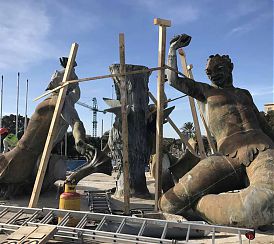HI-TECH MADE IN ITALY FOR THE RESTORATION OF MONUMENT OF MALTA


There is also ENEA in the all-Italian team that led the restoration of the Tritons’ Fountain on the island of Malta, thanks to a collaboration agreement with the Roman firm De Feo Restauri. The synergy between a highly specialized private company and a public research body has provided a hi-tech imprint for the restoration of the symbolic monument of the Maltese capital, initiating an effective technological transfer activity from the laboratory to the company. After twelve months of work, the piece of the sculptor Vincent Apap and architect Victor Anastasi has returned to ‘dominate’ the entrance of Valletta, declared European Capital of Culture 2018. The large travertine basin – with the center three Bronze tritons that support an additional tank, as well made of bronze – had been inaugurated in 1959 but over time, due to atmospheric agents it had lost its original splendor. ‘Our task – explains ENEA researcher Valeria Spizzichino – was first of all to identify the type of deterioration present on the surface of the fountain basin. We did this by using our laser eqipment on site, while we analyzed the samples taken in the laboratories of the ENEA Research Center in Casaccia and Frascati . This type of investigation – continues the researcher – allowed to identify the causes of degradation and to identify the most suitable restoration intervention ‘.
The ENEA researchers then tested, together with the restorers, different methods of chemical cleaning of the surface using four types of techniques on as many areas of the tank. All the compresses, consisting mostly of laponite and cellulose pulp, remained in contact with the surface of the fountain for around twenty-four hours. ‘Subsequently we analysed the treated parts, finding a different effectiveness associated with each treatment – emphasizes Spizzichino – but in no case traces of calcite removal of the travertine have been identified, meaning that no damage occurred to the treated material. Our diagnostic technologies – the researcher concludes – have allowed us to precisely identify the most suitable restoration for the fountain’.
The company De Feo Restauri, winner of the public tender announced by the Maltese government for the restoration of the fountain together with the companies Coge Impianti and Fonderia Marinelli, involved ENEA as a scientific partner for diagnostic investigations. Already in 2014, the Roman firm had worked on the restoration of the walls of Valletta as part of a larger project of redevelopment of the city started by architect Renzo Piano.
In addition to the restoration activities, sophisticated installations were carried out for the fountain, which saw the construction of a technical room below the square, a connecting tunnel of about 40 meters and a new pumping station, together with the installation of new hydraulic, electrical and mechanical systems, water treatment and a new lighting system.
Source: medNews

